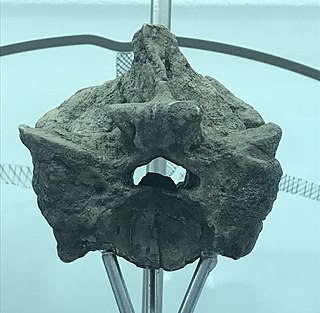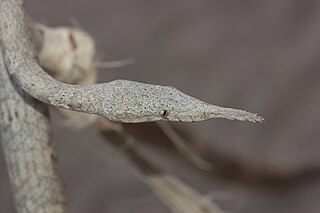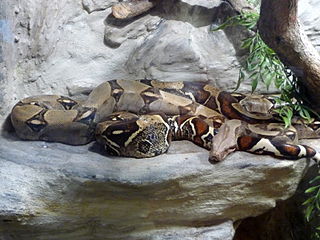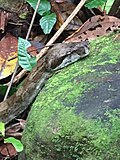
The Boidae, commonly known as boas or boids, are a family of nonvenomous snakes primarily found in the Americas, as well as Africa, Europe, Asia, and some Pacific islands. Boas include some of the world's largest snakes, with the green anaconda of South America being the heaviest and second-longest snake known; in general, adults are medium to large in size, with females usually larger than the males. Six subfamilies comprising 15 genera and 54 species are currently recognized.

Loxocemus bicolor, the sole member of the monotypic family Loxocemidae and commonly known as the Mexican python, Mexican burrowing python and Mexican burrowing snake, is a species of python-like snake found in Mexico and Central America. No subspecies are currently recognized. Analyses of DNA show that Loxocemus is most closely related to the true pythons and the sunbeam snakes.

The Calabar python is a species of non-venomous snake in the family Boidae. The species is endemic to West and Central Africa. It is the only species in its genus.

Sanzinia madagascariensis, also known as the Madagascar tree boa or Malagasy tree boa, is a boa species endemic to the island of Madagascar. It was once considered conspecific with the Nosy Komba ground boa. Like all other boas, it is non-venomous.

Acrantophis dumerili, commonly known as Dumeril's boa, is a species of non-venomous snake in the family Boidae. The species is endemic to Madagascar. No subspecies are currently recognized.

Acrantophis is a genus of terrestrial boid snakes endemic to the island of Madagascar.

Acrantophis madagascariensis is a species of boid snake in the subfamily Sanziniinae that is endemic to the island of Madagascar. Its common names include the Madagascar ground boa and Malagasy ground boa.

The Boinae are a purported subfamily of boas found in Central and South America, as well as the West Indies. In the Integrated Taxonomic Information System (ITIS), Boinae is considered an invalid synonym of Boidae.

Corallus cropanii, or Cropani's tree boa, is a species of boa, a snake in the family Boidae. The species is endemic to the state of São Paulo, Brazil. Like all boas, it is not venomous. No subspecies are currently recognized. Until 2017, no specimen of this snake had been seen alive since 1953 and only five dead specimens had been collected since then, but in late January 2017, an adult female Cropan's tree boa measuring 1.7 m was captured by locals in Ribeira who brought it to herpetologists from the Instituto Butantan and the Museum of Zoology of the University of São Paulo, who radio-tagged and released the animal to learn more about the species' behavior.

Lygodactylus blancae is a species of gecko, a lizard in the family Gekkonidae. The species is endemic to Madagascar.

Titanoboa is an extinct genus of giant boid snake that lived during the middle and late Paleocene. Titanoboa was first discovered in the early 2000s by the Smithsonian Tropical Research Institute who, along with students from the University of Florida, recovered 186 fossils of Titanoboa from La Guajira in northeastern Colombia. It was named and described in 2009 as Titanoboa cerrejonensis, the largest snake ever found. It was originally known only from thoracic vertebrae and ribs, but later expeditions collected parts of the skull and teeth. Titanoboa is in the subfamily Boinae, being most closely related to other extant boines from Madagascar and the Pacific.

Langaha madagascariensis is a medium-sized highly cryptic arboreal species. It is endemic to Madagascar and found in deciduous dry forests and rain forests, often in vegetation 1.5 to 2 meters above the ground.

The boa constrictor, also known as the common boa, is a species of large, non-venomous, heavy-bodied snake that is frequently kept and bred in captivity. The boa constrictor is a member of the family Boidae. The species is native to tropical South America. A staple of private collections and public displays, its color pattern is highly variable yet distinctive. Four subspecies are recognized.

Calumma amber, commonly known as the Amber Mountain chameleon, is a species of chameleons endemic to Antsiranana Province, Madagascar. The species was first observed in 1989 and was first described in 2006, and can only be found in the northernmost portion of the northern Diana Region of Madagascar, on and around Montagne d'Amber National Park. C. amber was originally considered to be a population of C. brevicorne.

The Sanziniinae are a subfamily of boid snakes containing four species endemic to the island of Madagascar. Common names include Madagascar boas and Malagasy boas.

The Booidea, also known as booid snakes, are a superfamily of snakes that contains boas and other closely related boa-like snakes. As of 2017, Booidea contains 61 species, including the eponymous neotropical Boa constrictor, anacondas, and smaller tree and rainbow boas as well as several genera of booid snakes from various locations around the world: bevel-nosed boas or keel-scaled boas (Candoia) from New Guinea and Melanesia, Old World sand boas (Eryx) from Northeast Africa, the Middle East, and Southwest Asia, rubber boas (Charina) and rosy boas (Lichanura) from North America, neotropical dwarf boas (Ungaliophis) and the Oaxacan dwarf boa (Exiliboa) from Central America, Madagascan boas or Malagasy boas from Madagascar, and the Calabar python (Calabaria) from tropical West-Central Africa.

The Nosy Komba ground boa is a boa species endemic to the island of Madagascar. It is brownish in colour and is found on the western side of the island. It was once considered conspecific with the Madagascar tree boa. Like all other boas, it is not venomous.

Thamnosophis stumpffi, commonly known as the yellow-striped water snake, is a species of snake in the subfamily Pseudoxyrhophiinae of the family Pseudoxyrhophiidae. The species is endemic to Madagascar.

Flexiseps alluaudi is a species of skink, a lizard in the family Scincidae. The species is endemic to Madagascar.

Flexiseps crenni is a species of skink, a lizard in the family Scincidae. The species is endemic to Madagascar.






















